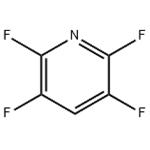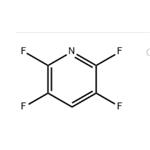Synthesis
Catalytic reduction of aryl chlorides, bromides and iodides is well documented,
however, aryl fluorides do not readily react under these conditions, owing to the strong
C-F bond and the high activation barrier to bond breaking. Work in our laboratories showed that at high temperatures, pentafluoropyridine was converted to 2,3,5,6-
tetrafluoropyridine using a palladium catalyst.

Preparation
An autoclave sprayed with PTFE was charged with pentafluoropyridine (20.0 g, 118 mmol), HBr (32.0 g, 400 mmol) and sulpholane (40 cm
3) and heated at 200 ℃ for 48 h. The mixture was added to water and extracted into ether. The ether solution was shown to contain pentafluoropyridine (79%) and 2,3,5,6-tetrafluoropyridine (21%) by comparison of their GCMS and fluorine nmr spectra with authentic samples.
Description
Pyridine and its derivatives have been developed and utilized relatively early at home and abroad. It is widely used in medicine, pesticides, rubber, dyes and other fields. Since the 1960s, there have been hundreds of medicines, pesticides, dyes, and some special reagents developed with fluorine-containing aromatic compounds as intermediates. In the weakly basic pyridine ring, the nitrogen atom is more negatively charged, and then a fluorine atom with a strong electronegativity is introduced to synthesize a fluorine-containing pyridine intermediate.
Chemical Properties
clear colorless liquid







